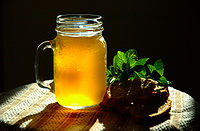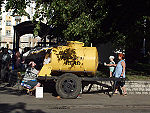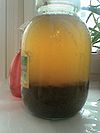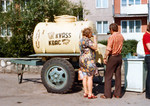
Kvass
Encyclopedia

Kvass, kvas, quass or gira, gėra (from Old East Slavic квасъ, kvasŭ, meaning "yeast" or "leaven"; today, in Belarusian
Belarusian language
The Belarusian language , sometimes referred to as White Russian or White Ruthenian, is the language of the Belarusian people...
: квас, kvas, сиривець, siriviets; Lithuanian
Lithuanian language
Lithuanian is the official state language of Lithuania and is recognized as one of the official languages of the European Union. There are about 2.96 million native Lithuanian speakers in Lithuania and about 170,000 abroad. Lithuanian is a Baltic language, closely related to Latvian, although they...
: gira; Russian
Russian language
Russian is a Slavic language used primarily in Russia, Belarus, Uzbekistan, Kazakhstan, Tajikistan and Kyrgyzstan. It is an unofficial but widely spoken language in Ukraine, Moldova, Latvia, Turkmenistan and Estonia and, to a lesser extent, the other countries that were once constituent republics...
: квас, kvas; in Ukrainian
Ukrainian language
Ukrainian is a language of the East Slavic subgroup of the Slavic languages. It is the official state language of Ukraine. Written Ukrainian uses a variant of the Cyrillic alphabet....
: квас, хлібний квас or сирівець, kvas, khlibnyy kvas or syrivets; Polish
Polish language
Polish is a language of the Lechitic subgroup of West Slavic languages, used throughout Poland and by Polish minorities in other countries...
kwas chlebowy) is a fermented beverage made from black or regular rye bread
Bread
Bread is a staple food prepared by cooking a dough of flour and water and often additional ingredients. Doughs are usually baked, but in some cuisines breads are steamed , fried , or baked on an unoiled frying pan . It may be leavened or unleavened...
. The colour of the bread used contributes to the colour of the resulting drink. It is classified as a non-alcoholic drink by Russian standards, as the alcohol
Alcohol
In chemistry, an alcohol is an organic compound in which the hydroxy functional group is bound to a carbon atom. In particular, this carbon center should be saturated, having single bonds to three other atoms....
content from fermentation is typically less than 1.2%. Overall, the alcohol content is low (0.05% - 1.0%). It is often flavoured with fruits or herb
Herb
Except in botanical usage, an herb is "any plant with leaves, seeds, or flowers used for flavoring, food, medicine, or perfume" or "a part of such a plant as used in cooking"...
s such as strawberries
Garden Strawberry
The garden strawberry, Fragaria × ananassa, is a hybrid species that is cultivated worldwide for its fruit, the strawberry. The fruit is widely appreciated for its characteristic aroma, bright red color, juicy texture, and sweetness...
or mint
Mentha
Mentha is a genus of flowering plants in the family Lamiaceae . The species are not clearly distinct and estimates of the number of species varies from 13 to 18. Hybridization between some of the species occurs naturally...
. Kvass is also used for preparing a cold summertime soup called okroshka
Okroshka
Okróshka is a cold soup of Russian origin that is also found in Ukraine. The name probably originates from "kroshit'" , which means to crumble into small pieces....
.
It is popular in Russia
Russia
Russia or , officially known as both Russia and the Russian Federation , is a country in northern Eurasia. It is a federal semi-presidential republic, comprising 83 federal subjects...
, Belarus
Belarus
Belarus , officially the Republic of Belarus, is a landlocked country in Eastern Europe, bordered clockwise by Russia to the northeast, Ukraine to the south, Poland to the west, and Lithuania and Latvia to the northwest. Its capital is Minsk; other major cities include Brest, Grodno , Gomel ,...
, Ukraine
Ukraine
Ukraine is a country in Eastern Europe. It has an area of 603,628 km², making it the second largest contiguous country on the European continent, after Russia...
, Lithuania
Lithuania
Lithuania , officially the Republic of Lithuania is a country in Northern Europe, the biggest of the three Baltic states. It is situated along the southeastern shore of the Baltic Sea, whereby to the west lie Sweden and Denmark...
, Latvia
Latvia
Latvia , officially the Republic of Latvia , is a country in the Baltic region of Northern Europe. It is bordered to the north by Estonia , to the south by Lithuania , to the east by the Russian Federation , to the southeast by Belarus and shares maritime borders to the west with Sweden...
, and other Eastern
Eastern Europe
Eastern Europe is the eastern part of Europe. The term has widely disparate geopolitical, geographical, cultural and socioeconomic readings, which makes it highly context-dependent and even volatile, and there are "almost as many definitions of Eastern Europe as there are scholars of the region"...
and Central Europe
Central Europe
Central Europe or alternatively Middle Europe is a region of the European continent lying between the variously defined areas of Eastern and Western Europe...
an countries as well as in former Soviet states, such as Kazakhstan
Kazakhstan
Kazakhstan , officially the Republic of Kazakhstan, is a transcontinental country in Central Asia and Eastern Europe. Ranked as the ninth largest country in the world, it is also the world's largest landlocked country; its territory of is greater than Western Europe...
, Uzbekistan
Uzbekistan
Uzbekistan , officially the Republic of Uzbekistan is a doubly landlocked country in Central Asia and one of the six independent Turkic states. It shares borders with Kazakhstan to the west and to the north, Kyrgyzstan and Tajikistan to the east, and Afghanistan and Turkmenistan to the south....
, where one can see many kvass vendors in the streets. Kvass is also popular in Harbin
Harbin
Harbin ; Manchu language: , Harbin; Russian: Харби́н Kharbin ), is the capital and largest city of Heilongjiang Province in Northeast China, lying on the southern bank of the Songhua River...
and Xinjiang
Xinjiang
Xinjiang is an autonomous region of the People's Republic of China. It is the largest Chinese administrative division and spans over 1.6 million km2...
, areas within China
China
Chinese civilization may refer to:* China for more general discussion of the country.* Chinese culture* Greater China, the transnational community of ethnic Chinese.* History of China* Sinosphere, the area historically affected by Chinese culture...
that are influenced by Russian culture.
History

Eastern Europe
Eastern Europe is the eastern part of Europe. The term has widely disparate geopolitical, geographical, cultural and socioeconomic readings, which makes it highly context-dependent and even volatile, and there are "almost as many definitions of Eastern Europe as there are scholars of the region"...
since ancient times, comparable with other ancient fermented grain beverages including beer
Beer
Beer is the world's most widely consumed andprobably oldest alcoholic beverage; it is the third most popular drink overall, after water and tea. It is produced by the brewing and fermentation of sugars, mainly derived from malted cereal grains, most commonly malted barley and malted wheat...
brewed from barley
Barley
Barley is a major cereal grain, a member of the grass family. It serves as a major animal fodder, as a base malt for beer and certain distilled beverages, and as a component of various health foods...
by the ancient Egyptians, the pombe or millet beer
Millet beer
Millet beer, also known as Bantu beer, kaffir beer, or opaque beer, is an alcoholic beverage made from malted millet. This type of beer is common throughout Africa. Related African drinks include maize beer and sorghum beer....
of Africa, the so-called rice wine
Rice wine
Rice wine is an alcoholic beverage made from rice. Unlike wine, which is made by fermentation of naturally sweet grapes and other fruit, rice "wine" results from the fermentation of rice starch converted to sugars...
s of Asia, the chicha
Chicha
For the musical genre, see Peruvian cumbiaChicha is a term used in some regions of Latin America for several varieties of fermented and non-fermented beverages, rather often to those derived from maize and similar non-alcoholic beverages...
made with corn or cassava
Cassava
Cassava , also called yuca or manioc, a woody shrub of the Euphorbiaceae native to South America, is extensively cultivated as an annual crop in tropical and subtropical regions for its edible starchy tuberous root, a major source of carbohydrates...
by the natives of America. Kvass was first mentioned in Old Rus Chronicles in the year 989. In Russia, under Peter the Great
Peter I of Russia
Peter the Great, Peter I or Pyotr Alexeyevich Romanov Dates indicated by the letters "O.S." are Old Style. All other dates in this article are New Style. ruled the Tsardom of Russia and later the Russian Empire from until his death, jointly ruling before 1696 with his half-brother, Ivan V...
, it was the most common non-alcoholic drink in every class of society. William Tooke
William Tooke
William Tooke was a British clergyman and historian of Russia.-Life:Tooke was the second son of Thomas Tooke of St. John's, Clerkenwell, by his wife Hannah, only daughter of Thomas Mann of St. James's, Clerkenwell, whom he married in 1738...
, describing Russian drinking habits in 1799, stated that
The most common domestic drink is quas, a liquor prepared from pollard, meal, and bread, or from meal and malt, by an acid fermentation. It is cooling and well-tasted.
Later, in the 19th century, it was reported to be consumed in excess by peasants, low-class citizens, and monks; in fact, it is sometimes said that it was usual for them to drink more kvass than water. It has been both a commercial product and homemade. It used to be consumed widely in most Slavic countries, where in almost every city there are kvass vendors on the street. Today it forms the basis of a multimillion-dollar industry. Kvass was once sold during the summer only, but is now produced, packaged, and sold year-round.
The town of Zvenigorod
Zvenigorod
Zvenigorod is an old town in Moscow Oblast, Russia. Population: -History:The community has existed since the 12th century, although its first written mention is dated 1338. The town's name is based either on a personal name or on a hydronym Zvenigorod is an old town in Moscow Oblast, Russia....
, west of Moscow, is known for its authentic, preservative-free kvass, which is brewed in the basement of the town's Orthodox monastery.
Manufacturing


Wheat
Wheat is a cereal grain, originally from the Levant region of the Near East, but now cultivated worldwide. In 2007 world production of wheat was 607 million tons, making it the third most-produced cereal after maize and rice...
, rye
Rye
Rye is a grass grown extensively as a grain and as a forage crop. It is a member of the wheat tribe and is closely related to barley and wheat. Rye grain is used for flour, rye bread, rye beer, some whiskeys, some vodkas, and animal fodder...
, or barley
Barley
Barley is a major cereal grain, a member of the grass family. It serves as a major animal fodder, as a base malt for beer and certain distilled beverages, and as a component of various health foods...
, and sometimes flavoured using fruit
Fruit
In broad terms, a fruit is a structure of a plant that contains its seeds.The term has different meanings dependent on context. In non-technical usage, such as food preparation, fruit normally means the fleshy seed-associated structures of certain plants that are sweet and edible in the raw state,...
, berries
Berry
The botanical definition of a berry is a fleshy fruit produced from a single ovary. Grapes are an example. The berry is the most common type of fleshy fruit in which the entire ovary wall ripens into an edible pericarp. They may have one or more carpels with a thin covering and fleshy interiors....
, raisin
Raisin
Raisins are dried grapes. They are produced in many regions of the world. Raisins may be eaten raw or used in cooking, baking and brewing...
s, or birch sap
Birch sap
Birch sap is the sap extracted from a birch tree, such as a North American Sweet Birch or a Silver Birch. The sap is often a slightly sweet, thin syrupy-watery liquid...
collected in the early spring. Modern homemade kvass most often uses black or regular rye bread
Bread
Bread is a staple food prepared by cooking a dough of flour and water and often additional ingredients. Doughs are usually baked, but in some cuisines breads are steamed , fried , or baked on an unoiled frying pan . It may be leavened or unleavened...
, usually dried, baked into crouton
Crouton
A crouton is a small piece of sautéed or rebaked bread, often cubed and seasoned, that is used to add texture and flavor to salads, notably the Caesar salad, as an accompaniment to soups, or eaten as a snack food. The word crouton is derived from the French croûton, itself derived from croûte,...
s (called suhari), or fried, with the addition of sugar
Sugar
Sugar is a class of edible crystalline carbohydrates, mainly sucrose, lactose, and fructose, characterized by a sweet flavor.Sucrose in its refined form primarily comes from sugar cane and sugar beet...
or fruit (e.g. apples or raisins), and with a yeast
Yeast
Yeasts are eukaryotic micro-organisms classified in the kingdom Fungi, with 1,500 species currently described estimated to be only 1% of all fungal species. Most reproduce asexually by mitosis, and many do so by an asymmetric division process called budding...
culture and zakvaska ("kvass fermentation starter
Fermentation starter
Fermentation starters are preparations to assist the beginning of the fermentation process in preparation of various foods and fermented drinks. A starter culture is a microbiological culture which actually performs fermentation...
").
Commercial kvass, especially less expensive varieties, is occasionally made like many other soft drinks, using sugar, carbonated water, malt extract, and flavourings. Better brands, often made by beer rather than soft drink manufacturers, usually use a variation of the traditional process to brew their products. Kvass is commonly served unfiltered, with the yeast still in it, which adds to its unique flavour as well as its high vitamin B
B vitamins
B vitamins are a group of water-soluble vitamins that play important roles in cell metabolism. The B vitamins were once thought to be a single vitamin, referred to as vitamin B . Later research showed that they are chemically distinct vitamins that often coexist in the same foods...
content.
There is only one brewery in the United States that brews a Kvass year round. That is the Beaver Brewing Company in Beaver Falls Pennsylvania. They make it with the addition of raisins and lemons.
Russia
According to the Merriam Webster Dictionary the first mention of kvass took place sometime around 1553. Although the introduction of western soft drinks such as Coca-ColaCoca-Cola
Coca-Cola is a carbonated soft drink sold in stores, restaurants, and vending machines in more than 200 countries. It is produced by The Coca-Cola Company of Atlanta, Georgia, and is often referred to simply as Coke...
and Pepsi
Pepsi
Pepsi is a carbonated soft drink that is produced and manufactured by PepsiCo...
had negatively impacted the commercial sale of kvass in Russia, kvass has been more recently marketed as a patriotic alternative to cola, sparking a "kvass revival". For example, the Russian company Nikola (whose name sounds like "not cola" in Russian
Russian language
Russian is a Slavic language used primarily in Russia, Belarus, Uzbekistan, Kazakhstan, Tajikistan and Kyrgyzstan. It is an unofficial but widely spoken language in Ukraine, Moldova, Latvia, Turkmenistan and Estonia and, to a lesser extent, the other countries that were once constituent republics...
) has promoted its brand of kvass with an advertising campaign emphasizing "anti cola-nisation." Moscow-based Business Analytica reported in 2008 that bottled kvass sales had tripled since 2005 and estimated that per-capita
Per capita
Per capita is a Latin prepositional phrase: per and capita . The phrase thus means "by heads" or "for each head", i.e. per individual or per person...
consumption of kvass in Russia would reach three liters in 2008. Between 2005 and 2007, cola's share of the Moscow soft drink market fell from 37% to 32%. Meanwhile, kvass's share more than doubled over the same time period, reaching 16% in 2007. In response, Coca-Cola launched its own brand of kvass in May 2008. This is the first time a foreign company has made a significant entrance into the Russian kvass market. Pepsi has also signed an agreement with a Russian kvass manufacturer to act as a distribution agent. The development of new technologies for storage and distribution, and heavy advertising, have contributed to this surge in popularity; three new major brands have been introduced since 2004.
Latvia

Cultural references
Kvass has a long tradition in Russian culture. In Fyodor DostoevskyFyodor Dostoevsky
Fyodor Mikhaylovich Dostoyevsky was a Russian writer of novels, short stories and essays. He is best known for his novels Crime and Punishment, The Idiot and The Brothers Karamazov....
's The Brothers Karamazov
The Brothers Karamazov
The Brothers Karamazov is the final novel by the Russian author Fyodor Dostoyevsky. Dostoyevsky spent nearly two years writing The Brothers Karamazov, which was published as a serial in The Russian Messenger and completed in November 1880...
, monastery kvass is mentioned in the dinner scene as being famous throughout the neighborhood. In Leo Tolstoy
Leo Tolstoy
Lev Nikolayevich Tolstoy was a Russian writer who primarily wrote novels and short stories. Later in life, he also wrote plays and essays. His two most famous works, the novels War and Peace and Anna Karenina, are acknowledged as two of the greatest novels of all time and a pinnacle of realist...
's The Death of Ivan Ilyich
The Death of Ivan Ilyich
The Death of Ivan Ilyich , first published in 1886, is a novella by Leo Tolstoy, and is considered to be one of the masterpieces of his late fiction, written shortly after his religious conversion of the late 1870s.-Characters:...
, kvass is made first thing on a holiday morning. In Anton Chekhov
Anton Chekhov
Anton Pavlovich Chekhov was a Russian physician, dramatist and author who is considered to be among the greatest writers of short stories in history. His career as a dramatist produced four classics and his best short stories are held in high esteem by writers and critics...
's The Cherry Orchard
The Cherry Orchard
The Cherry Orchard is Russian playwright Anton Chekhov's last play. It premiered at the Moscow Art Theatre 17 January 1904 in a production directed by Constantin Stanislavski. Chekhov intended this play as a comedy and it does contain some elements of farce; however, Stanislavski insisted on...
, kvass is mentioned early in the play, "Bring me some kvass, would you?". In Ivan Goncharov
Ivan Goncharov
Ivan Alexandrovich Goncharov was a Russian novelist best known as the author of Oblomov .- Biography :Ivan Goncharov was born in Simbirsk ; his father was a wealthy grain merchant and respected official who was elected mayor of Simbirsk several times...
's Oblomov
Oblomov
Oblomov is the best known novel by Russian writer Ivan Goncharov, first published in 1859. Oblomov is also the central character of the novel, often seen as the ultimate incarnation of the superfluous man, a symbolic character in 19th-century Russian literature...
and in Tolstoy's Anna Karenina
Anna Karenina
Anna Karenina is a novel by the Russian writer Leo Tolstoy, published in serial installments from 1873 to 1877 in the periodical The Russian Messenger...
, kvass is repeatedly mentioned. In Tolstoy's War and Peace
War and Peace
War and Peace is a novel by the Russian author Leo Tolstoy, first published in 1869. The work is epic in scale and is regarded as one of the most important works of world literature...
, French soldiers are aware of kvass on entering Moscow, enjoying it but referring to it as "pig's lemonade".In Sholem Aleichem's Motl, Peysi the Cantor's Son, diluted kvass is the focus of one of Motl's older brother's get rich quick schemes. The Russian expression "Перебиваться с хлеба на квас" (literally "to clamber from bread to kvass") means to barely make ends meet, remotely similar to (and may be translated as) the expression "to be on the breadline
Soup kitchen
A soup kitchen, a bread line, or a meal center is a place where food is offered to the hungry for free or at a reasonably low price. Frequently located in lower-income neighborhoods, they are often staffed by volunteer organizations, such as church groups or community groups...
". To better understand the Russian phrase one has to know that in poor families kvass was made from stale leftovers of rye bread
Rye bread
Rye bread is a type of bread made with various percentages of flour from rye grain. It can be light or dark in color, depending on the type of flour used and the addition of coloring agents, and is typically denser than bread made from wheat flour...
. In Against Nature
Against Nature
Against Nature may refer to:*À rebours, a French novel by Joris-Karl Huysmans*A television documentary by Martin Durkin *Against Nature , a 1989 rock album by The Fatima Mansions...
(À rebours
À rebours
À rebours is a novel by the French writer Joris-Karl Huysmans...
) the protagonist, Jean Des Esseintes serves kvass, along with porter and stout, for a funeral banquet "in memory of the host's virility, lately but only temporarily deceased."
Similar beverages
Other beverages from around the world that are traditionally low-alcohol and lacto-fermented include:- BozaBozaBoza, also bosa , is a popular fermented beverage in Kazakhstan, Turkey, Kyrgyzstan, Albania, Bulgaria, Macedonia, Montenegro, Bosnia and Herzegovina, parts of Romania, Serbia, Ukraine and also Poland and Lithuania...
- ChichaChichaFor the musical genre, see Peruvian cumbiaChicha is a term used in some regions of Latin America for several varieties of fermented and non-fermented beverages, rather often to those derived from maize and similar non-alcoholic beverages...
- IbwatuIbwatuIbwatu or munkoyo is one of rural Zambia's favourite drinks. It is a mildly fermented drink made from pounded roots mixed with bits of maize. The mixture can be drunk immediately after it is made or allowed to ferment for several days. It is often called "sweet beer" by Zambians...
- KombuchaKombuchaKombucha is an effervescent tea-based beverage that is often drunk for its anecdotal health benefits or medicinal purposes. Kombucha is available commercially and can be made at home by fermenting tea using a visible, solid mass of yeast and bacteria which forms the kombucha culture, often referred...
- MaltaMalta (soft drink)Malta, young beer, Children's beer or wheat soda is a type of soft drink. It is a carbonated malt beverage, meaning it is brewed from barley, hops, and water much like beer; corn and caramel color may also be added...
- ToddyPalm winePalm wine also called Palm Toddy also called "Kallu" written in Malayalam and கள்ளு in Tamil or simply Toddy is an alcoholic beverage created from the sap of various species of palm tree such as the palmyra, and coconut palms...
- RivellaRivellaRivella is a soft drink from Switzerland, created by Robert Barth in 1952, which is produced from milk whey, and therefore includes ingredients such as lactose, lactic acid and minerals...
- Bragǎ – Romanian traditional soft drink
External links
- Sally Fallon, "Kvass and Kombucha: Gifts From Russia", Weston A. Price Foundation
- Kvas in the United States: Traditional Russian beverage wins Americans’ hearts

